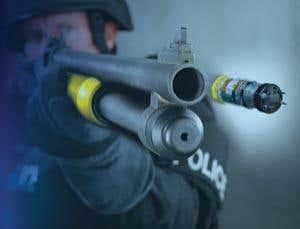Table of Contents
- Understanding the Anatomy Behind Effective Stun Gun Usage
- Targeting the Central Nervous System for Optimal Results
- Avoiding Bone and Clothing Interference During Deployment
- Safety Considerations When Choosing Your Aim Point
- Key Takeaways
Understanding the Anatomy Behind Effective Stun Gun Usage
For optimal results when using a stun gun, it’s crucial to understand the physiological makeup of the human body and how the device disrupts the nervous system. The stun gun works by delivering a high-voltage, low-amperage electric shock that temporarily interferes with the target’s neuromuscular functions. Target areas rich in motor nerves and muscle mass will maximize the incapacitating effect because the electric current causes involuntary muscle contractions, stunning the individual effectively. The most responsive zones include regions where the nerves are more superficial and closer to the skin, minimizing the resistance and allowing a stronger electric flow.
Key anatomical targets to consider:
- Upper thigh inner area: Dense muscle groups and close to the femoral nerve.
- Back of the shoulder (deltoid region): Contains major nerves that control arm and shoulder movement.
- Abdomen and lower back: Central nervous system pathways run close to the skin and can be disrupted effectively.
- Chest area near the clavicle: This area leads to rapid neuromuscular incapacitation.
Understanding these areas can drastically improve the efficacy of a stun gun by ensuring the electric shock hits the zones where it causes the most disruption to nerve signals, rendering the target immobilized for critical moments-providing a tactical advantage in self-defense situations.
Targeting the Central Nervous System for Optimal Results
When deploying a stun gun, precision is critical for quickly incapacitating a threat. The most effective areas to target are those that directly influence the central nervous system (CNS). Striking these points disrupts the electrical signals in the body, causing immediate loss of motor control and disorientation. Key zones include the upper chest between the collarbones, the side of the neck near the carotid artery, and the upper back region near the spine. These areas are densely packed with nerve clusters that relay signals to the brain, making them prime spots for maximal neurological impact.
Remember these targeting essentials for optimal stun gun effectiveness:
- Aim for exposed flesh: Avoid thick clothing or belts that can reduce the stun gun’s impact.
- Avoid the head: Targeting the head carries risks of serious injury; the CNS zones in the torso are safer and highly effective.
- Focus on quick, controlled applications: A brief but firm contact delivers enough charge to disrupt nerve impulses without causing long-term harm.
- Maintain a steady grip and stance: Proper positioning enhances precision and prevents losing control during use.
Avoiding Bone and Clothing Interference During Deployment
When deploying a stun gun, it’s crucial to ensure the electric probes make direct contact with the skin. Thick clothing, especially heavy jackets or multiple layers, can significantly reduce the device’s effectiveness by preventing the current from passing through properly. To maximize results, aim for exposed areas or thin fabric regions like the chest or inner arms, avoiding spots with dense layers. Additionally, be mindful of underlying bones such as the collarbone or shin, as they can impede the flow of electricity, minimizing the stun gun’s impact.
Consider these quick tips to avoid interference and boost effectiveness:
- Opt for areas with minimal clothing coverage, such as the upper thigh or neck region.
- Steer clear of bony prominences, like the collarbone or wrist bones, to improve contact.
- Ensure probes maintain firm contact with the target, pressing gently if necessary.
By focusing on soft tissue areas with thin or no clothing and avoiding bones, you optimize the stun gun’s ability to disrupt muscle control effectively, ensuring both safety and control during deployment.
Safety Considerations When Choosing Your Aim Point
When selecting your target area, always prioritize safety to prevent unnecessary harm or injury. Aim points that target large muscle groups or areas with more fat and tissue, such as the thigh or forearm, can reduce the risk of causing permanent damage while still delivering effective shock. Avoid sensitive zones like the head, neck, or chest, as these regions contain vital organs and nerves that could be seriously affected by an electrical discharge. Understanding anatomy and proper aim points helps maintain the balance between defense and responsible use.
Additionally, be mindful of the surroundings and bystanders to prevent accidental harm. Ensure your line of sight is clear and that no unintended targets are in proximity. When in doubt, follow these key safety tips:
- Check for obstacles that may interfere with your aim or cause ricochet effects.
- Maintain a safe distance to avoid fall-related injuries after the target is incapacitated.
- Regularly train on simulator devices to improve accuracy and reduce risk in real encounters.
Key Takeaways
In conclusion, understanding where to aim a stun gun can significantly increase its effectiveness in a self-defense situation. Targeting areas with thinner skin and high nerve concentration-such as the torso or upper thigh-can maximize the device’s impact, providing you the crucial seconds needed to escape danger. Remember, proper usage and awareness of local laws are just as important as aim when it comes to personal safety tools. Stay informed, stay prepared, and always prioritize your safety first.Check Our Other Blogs
- StunGun – Your Trusted Source for Stun Guns, Laws, and Self-Defense Tips
- PepperSprayLaws – Your Trusted Resource for Pepper Spray Information
- StunGunLaws – Your Trusted Guide to Stun Gun Legality and Safety



